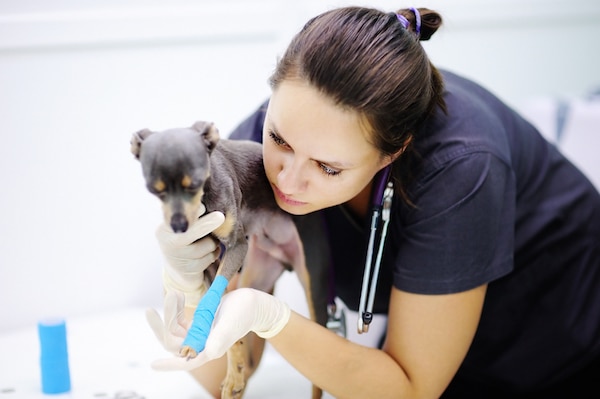If you find the topic of pet insurance confusing, you’re not alone. Many people wonder if they should buy pet insurance, but aren’t sure if it’s worth the money. There is no one correct answer for every person and every dog, but understanding how pet insurance works can help you decide if it’s right for you. Here are some things you need to know before buying pet insurance.
1. Pet insurance does NOT cover costs up front
With most human health insurance, you pay only the co-pay and the insurance company reimburses the doctor for the balance. Pet insurance works differently. Typically, you pay your veterinarian for all services rendered, then submit a claim to the pet insurance company, which mails you a reimbursement check.
2. Pet insurance does NOT cover well-pet services
Pet insurance provides coverage for illnesses and injuries only; it does not cover preventive and annual checkup-type services, such as vaccines, annual bloodwork, dental cleanings, or heartworm medications.
Some providers offer wellness plans, which are basically the opposite of pet insurance. Wellness plans do not cover illnesses or injuries, but reimburse you a set amount for vaccines and other well-pet services. You can often add a wellness plan to your illness and injury policy for an additional fee. Wellness plans might be a good idea for people who have trouble budgeting throughout the year, although the cost savings for wellness plans are often minimal or nonexistent.

Vet exams dog with broken leg by Shutterstock.
3. Pet insurance is ideal for younger dogs
If you have a new puppy with no known health problems, buying pet insurance might make financial sense. Puppies are generally the least expensive to insure, and they can also get into quite a bit of trouble. It’s not uncommon for rambunctious puppies to chew and swallow things they shouldn’t or become injured while playing. One bowel-obstruction surgery or knee repair can easily make your policy worthwhile.
4. Pet insurance is less cost-effective for older dogs
The older a dog is, the more expensive he is to insure. This is because older dogs tend to develop more health problems like arthritis, cancer, and diabetes. If your senior dog has never been insured, any pre-existing health conditions he already has will not be covered, so it might not make financial sense to insure him. In fact, many companies “age out” dogs at a certain point and will not offer coverage at any price.
However, if your young-adult or middle-aged dog has not experienced any health issues to date, you might be able to find a policy with a premium that isn’t too high to give you peace of mind that if he does become ill or injured, he will have coverage.
5. All pet insurance policies are NOT the same
If you decide to purchase pet insurance for your dog, be careful: Navigating the world of pet insurance is confusing, and you need to do your research to avoid getting burned. Here are the key areas to look at when comparing policies:
6. Premiums, deductibles and payouts are cornerstones
Your annual premium (the cost to purchase insurance for one year) is based on several factors, including your dog’s breed and age, whether he is spayed or neutered, and where you live.
The deductible is the amount you must pay out of pocket before the provider will reimburse you for covered expenses. Some providers offer different tiers of deductible: low, mid-range, and high. In general, the higher your deductible, the lower your annual premium will be.
The payout is how much money you will be reimbursed by the insurance company. Some pet insurance providers offer different tiers of payout of the claim after the deductible: low (for instance, 80 percent), mid-range (90 percent), and high (100 percent). In general, the higher your payout percentage, the higher your annual premium will be. Most pet insurance companies cap payouts at a certain dollar amount annually, and some allow you to choose your cap. Again, a higher total annual payout will result in a higher annual premium.
7. All deductibles are NOT the same (this is very important!)
Depending on the pet insurance company, the deductible will either be annual, per condition/incident, or per visit. The best option is annual — once you reach the deductible, you are set for the year, no matter how many times your dog goes to the vet. “Per condition/incident” means you only pay the deductible once in a calendar year for the same problem.
For instance, if your dog has allergies and goes to the vet four times in a year for his allergies, you only need to reach the deductible once and then all future care is covered. “Per visit” is your worst option. It means that every time your dog goes to the vet, you must pay the deductible before anything will be covered.
8. Some things are NOT covered
Before purchasing a pet insurance policy, carefully review it so you know what is covered and what is not. If you are unclear about what is covered, call the company and ask them to clarify. Some policies exclude major issues like cancer or hip dysplasia; others cover these types of events. Some insurance plans exclude or limit the benefits for cancer treatment, but offer cancer riders you can add on to your policy for an additional fee.
9. Purebred dogs may be subject to exclusions
If you own a purebred dog, listen up. A number of pet insurance policies exclude diseases and conditions that are genetically linked to certain breeds, for instance, hip dysplasia in a giant breed, or cancer in a Golden Retriever. If you own a purebred dog, choose a pet insurance provider that does not exclude hereditary conditions in purebreds.

Golden Retriever by Shutterstock.
10. Customer service matters
This is an often overlooked but important area to consider when choosing a provider. Ask your friends, family, and veterinarian about the providers you’re interested in. Search out reviews on social media and other sites to see how people like the customer service. Does the company review and pay claims in a timely manner? Do they fairly reimburse for covered conditions? A company with a good reputation for customer service is superior to one with shoddy reviews.
Why I chose to buy pet insurance
We decided to buy pet insurance for my Miniature Poodle Jäger when he was a puppy. The first three years, he had a major illness or injury each year, which more than made the insurance worthwhile. In his fourth year, we made no claims, but when Jäger was 5 years old, he broke a tooth and needed a root canal (you can read about that here).
All in all, the insurance was worthwhile for us. Jäger is 7 now, and we probably won’t be renewing his policy when it expires. The premium has gone up over the years, and at this point it seems to make more sense to just put that money in a savings account for him every year.
Actually, that’s exactly what many dog owners choose to do instead of buying insurance. If you put $300 or $400 a year into a savings account specially set aside for your dog, you can grow that into a nice little sum that will be waiting in case your dog ever has a major illness or injury. Of course, a major veterinary issue can cost into the thousands — $300 a year might not cut it if your dog is hit by a car when he’s 4 years old and needs a $3,000 surgery.
On the other hand, you could buy an insurance policy for your puppy and never have to use it beyond a random claim for diarrhea or an ear infection. Whether you’re buying it for yourself, your dog, or even your iPhone, insurance is a gamble. You might never need it, but if you do, you will be glad you have it.
Major pet insurance companies
Take a look at this list of pet insurance providers for a brief comparison of some of the most important items to consider when selecting pet insurance. Always read (and re-read!) the fine print before choosing a plan for your dog. For more in-depth reviews of these and other pet insurance companies, check out the Pet Insurance Comparison at Canine Journal.
ASPCA
- Payouts: Up to 90 percent reimbursement depending on the plan you choose
- Deductible: Annual
- Hereditary/congenital conditions: Coverage available (not all plans cover these conditions)
- Multiple pet discount: Yes
Embrace
- Payouts: 70 percent, 80 percent, or 90 percent reimbursement depending on the plan you choose
- Deductible: Annual
- Hereditary/congenital conditions: Covered if they are not pre-existing
- Multiple pet discount: Yes
Figo
- Payouts: 70 percent, 80 percent, 90 percent, or 100 percent reimbursement depending on the plan you choose
- Deductible: Annual
- Hereditary/congenital conditions: Covered if they are not pre-existing
- Multiple pet discount: Yes
Healthy Paws
- Payouts: 70 percent, 80 percent, or 90 percent reimbursement depending on the plan you choose (exam fees not covered); unlimited payouts
- Deductible: Annual
- Hereditary/congenital conditions: Covered if they are not pre-existing
- Multiple pet discount: No
Nationwide (formerly Veterinary Pet Insurance/VIP)
- Payouts: 90 percent reimbursement with the most expensive plan option (Whole Pet with Wellness); for all other plans, reimbursement is capped at a set amount for each condition, regardless of the actual treatment cost
- Deductible: Annual
- Hereditary/congenital conditions: Only covered under the most expensive plan option (Whole Pet with Wellness)
- Multiple pet discount: No
PetFirst
- Payouts: 70 percent, 80 percent, 90 percent, or 100 percent reimbursement depending on the plan you choose
- Deductible: Per incident
- Hereditary/congenital conditions: Covered if they are not pre-existing
- Multiple pet discount: Yes
PetPlan
- Payouts: May choose 70 percent, 80 percent, or 90 percent payouts; unlimited coverage available
- Hereditary/congenital conditions: Covered if they are not pre-existing
- Deductible: Annual
- Multiple pet discount: No
Pets Best
- Payouts: May choose 70 percent, 80 percent, or 90 percent payouts; unlimited coverage available with most expensive plan option; exam fees not covered under least expensive plan option
- Deductible: Annual
- Hereditary/congenital conditions: Covered if they are not pre-existing
- Multiple pet discount: Yes
Trupanion
- Payouts: 90 percent payouts (exam fees not covered); unlimited payouts.
- Hereditary/congenital conditions: Covered if they are not pre-existing.
- Deductible: Once per condition; may choose $0 to $1,000 deductible.
- Multiple pet discount: No.
The post 10 Things to Know About Pet Insurance Before You Buy a Policy appeared first on Dogster.
No comments:
Post a Comment